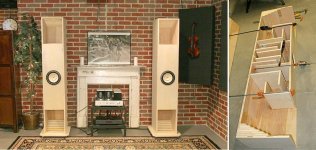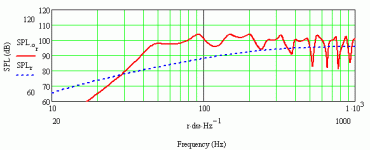Hi all,
all the recent threads on the Fe206ES-R cabinet have made me look at it closer even if I don't own those drivers. It seems to be a refined and 20% wider version of the Fostex Fe166ES-R cabinet.
The back chamber is 26% larger as well.
They doubled the baffle panel and appear to have added some panels to stiffen it up by spliting the horn path down the middle by inserting some panels like #33, 34, 35 & 36 (on 206esr cab) or maybe this is to reduce the airflow turbulance.
I'm wondering now if I should build the 206esr cabinet instead for my 166esr. Big is better for horns to a certain extent right? of course I may need more stuffing in the back chamber to reduce the volume a bit....
any comments?
Thanks
paba
all the recent threads on the Fe206ES-R cabinet have made me look at it closer even if I don't own those drivers. It seems to be a refined and 20% wider version of the Fostex Fe166ES-R cabinet.
The back chamber is 26% larger as well.
They doubled the baffle panel and appear to have added some panels to stiffen it up by spliting the horn path down the middle by inserting some panels like #33, 34, 35 & 36 (on 206esr cab) or maybe this is to reduce the airflow turbulance.
I'm wondering now if I should build the 206esr cabinet instead for my 166esr. Big is better for horns to a certain extent right? of course I may need more stuffing in the back chamber to reduce the volume a bit....
any comments?
Thanks
paba
Yes! You should build the larger cabinet. Bigger is better.
OK, so that's the slightly irrational response, but within reason, a larger cabinet is better -just damp it down if things get a bit lively. You can always get rid of something you have too much of. Boosting what you don't have in the first place is a trifle harder.
Of course, if you want big (as in big) you could always try these... (In point for fact these are the Sachiko's, for 8in drivers -there's a narrower version called Hiro for the 6 1/2in drivers, but since we're talking about 6 1/2in units into 8in cabinets... 😀 Would probably need damping a little, like the 206ES-R box, but I bet it'd be fun. 😉 I might run a model of them to find out, out of interest.)
OK, so that's the slightly irrational response, but within reason, a larger cabinet is better -just damp it down if things get a bit lively. You can always get rid of something you have too much of. Boosting what you don't have in the first place is a trifle harder.
Of course, if you want big (as in big) you could always try these... (In point for fact these are the Sachiko's, for 8in drivers -there's a narrower version called Hiro for the 6 1/2in drivers, but since we're talking about 6 1/2in units into 8in cabinets... 😀 Would probably need damping a little, like the 206ES-R box, but I bet it'd be fun. 😉 I might run a model of them to find out, out of interest.)
Attachments
Hey,
I haven't removed the Hiro off my list but I think the Sachiko is just too tall for my basement.
Must confess my mind's eye (3D visual) still hasn't fully undertood "Panel A" in the drawing and where the air flows around it.
So my preferences then in order are:
1) Hiro or FE206ES-R cab
2) Fe166ES-R cab
3) Ron's A166
4) Ron's Dallas II
You mentioned before that both the Hiro and Sachiko plans are being revised and updated with some improvements and idea when those will pop up on the web site?
/Paba
I haven't removed the Hiro off my list but I think the Sachiko is just too tall for my basement.
Must confess my mind's eye (3D visual) still hasn't fully undertood "Panel A" in the drawing and where the air flows around it.
So my preferences then in order are:
1) Hiro or FE206ES-R cab
2) Fe166ES-R cab
3) Ron's A166
4) Ron's Dallas II
You mentioned before that both the Hiro and Sachiko plans are being revised and updated with some improvements and idea when those will pop up on the web site?
/Paba
Just run the model for fun -I have the design saved in MathCad so all I needed to do was enter the T/S parameters for the 166ES-R. FR attached. Hiro is the same height as Sachiko BTW.
The only update to Hiro & Sachiko is an adjustment to the angle of the strike plates (or stepped expansion if that is used). They finish on the top & bottom panels in the same place, but are 3in taller up the rear panel. Improves the expansion of the final stage.
Panel A have a couple of optional extensions to brace the rear of the driver magnet. They're drilled so air can still flow in the filter chamber. Not critical -just a tweak that people can try if they feel so inclined.
Ron's horns are probably the most advanced BLHs in the world, but in keeping with Ron's hyper-precise approach, they are very carefully optimised to specific drivers. The ES-R should still drop into them, but the precision-engineering & tailoring goes out the window a bit.
The only update to Hiro & Sachiko is an adjustment to the angle of the strike plates (or stepped expansion if that is used). They finish on the top & bottom panels in the same place, but are 3in taller up the rear panel. Improves the expansion of the final stage.
Panel
Ron's horns are probably the most advanced BLHs in the world, but in keeping with Ron's hyper-precise approach, they are very carefully optimised to specific drivers. The ES-R should still drop into them, but the precision-engineering & tailoring goes out the window a bit.
Attachments
Hiro is the same height as Sachiko BTW.
Good point what was I thinking...
Panel A have a couple of optional extensions to brace the rear of the driver magnet. They're drilled so air can still flow in the filter chamber. Not critical -just a tweak that people can try if they feel so inclined.
I see, I think when I have the plywood infront of me it might come together in my mind.
I'm sorry I don't know how to interpret that graph. Except for the fact that it seems to move around the 100dB line starting at 50hz and if that's correct wow, plenty of bass. Now fed from a tube amp with a more than zero output impedance it might impact things in the 40Hz area right?
thanks
paba
Good point what was I thinking...
Panel
I see, I think when I have the plywood infront of me it might come together in my mind.
I'm sorry I don't know how to interpret that graph. Except for the fact that it seems to move around the 100dB line starting at 50hz and if that's correct wow, plenty of bass. Now fed from a tube amp with a more than zero output impedance it might impact things in the 40Hz area right?
thanks
paba
Half-space frequency response graph. The blue line is the driver's infinite baffle response, the red line the system frequency response radiating into half-space (basically a floor, nothing else assumed). It's a relatively high-gain design with catenoid flare profile, so over the horn's passband of operation (50Hz - 350Hz) you've got about 98 - 99db efficiency at 1w /1m input to ~50Hz. In-room, with your amp, you should be good to approx. 40Hz, & useable down to 30. I suspect LF power is not something you'd feel a lack of. The multiple bends & stepped expansion should also help filter off some of the unwanted higher frequency standing waves.
Hope that helps
Scott
Hope that helps
Scott
if it's of any use to you
i asked the same question back when i had considered a pair or 206esr's . already had the 166esr's but was thinking along the same lines regarding cabs .
however
my listening room is small and i like the Austin (esp. the layertone). i wanted to know what would need to be altered for use with the 166esr . the following are the answers which i got via e:mail with ron questioning the req. cc volume/166esr and fostex rec. blh vs. the Austin /166esr :
"CC volume=2.74 liters when a 12.7 "x12.7 "baffle is used for that driver. Either that or a 12.7 "round baffle."
"ron"
"In a room that small i would be building the A126 unless you already have the larger drivers.If you have the larger drivers already then the Austin would be a much better build than the Fostex horn.I can see where they were trying to go with their design principal, but the loss of pressure between the BR section and the necessary TL/horn action wasent balanced correctly so all 3 actions suffer. IMO their design principal would be better with a driver that was higher Qts and had greater displacement."
"ron"
i asked the same question back when i had considered a pair or 206esr's . already had the 166esr's but was thinking along the same lines regarding cabs .
however
my listening room is small and i like the Austin (esp. the layertone). i wanted to know what would need to be altered for use with the 166esr . the following are the answers which i got via e:mail with ron questioning the req. cc volume/166esr and fostex rec. blh vs. the Austin /166esr :
"CC volume=2.74 liters when a 12.7 "x12.7 "baffle is used for that driver. Either that or a 12.7 "round baffle."
"ron"
"In a room that small i would be building the A126 unless you already have the larger drivers.If you have the larger drivers already then the Austin would be a much better build than the Fostex horn.I can see where they were trying to go with their design principal, but the loss of pressure between the BR section and the necessary TL/horn action wasent balanced correctly so all 3 actions suffer. IMO their design principal would be better with a driver that was higher Qts and had greater displacement."
"ron"
Ron's not wrong either (not that you'd expect him to be) about the Fostex boxes. The ES-R horns are actually as far as I can see warmed over & slightly re-sized Nagaoka D37s & D58s. Not that that's intrinsically a bad thing, but the original boxes were indeed designed for higher Q drivers -the FE168Sigma (0.37Qt) and FE208Sigma (0.21Qt) respectively.
Interesting info. re the adjusted volume for the ES-R in the A166.
Interesting info. re the adjusted volume for the ES-R in the A166.
- Status
- Not open for further replies.
- Home
- Loudspeakers
- Full Range
- using the 206ESR cabinet for 166ESR

